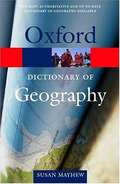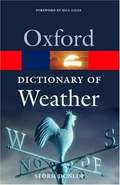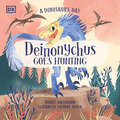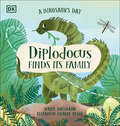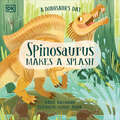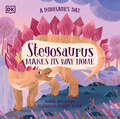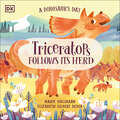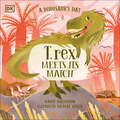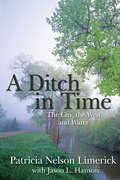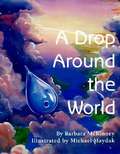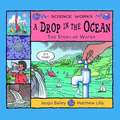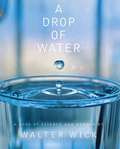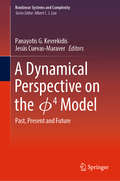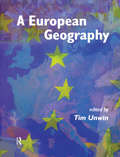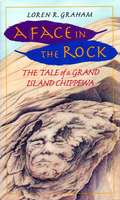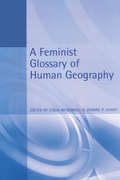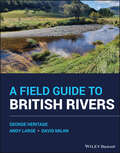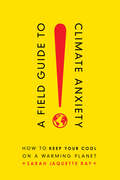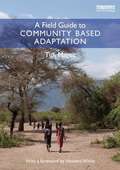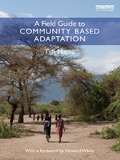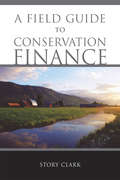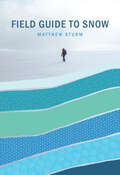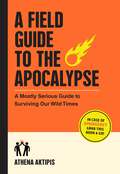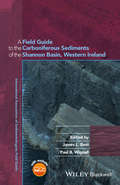- Table View
- List View
A Dictionary of Geography
by Susan MayhewThis unique new dictionary offers comprehensive coverage of words and terms encountered in both human and physical geography in a single volume. Each of the over 6,000 updated, clear, and concise entries provides an initial brief definition followed by a more in-depth explanation, making the book useful for novices and experts alike. This new edition also features a fact-finder with key economic and population statistics. Authoritative and completely accessible, A Dictionary of Geography, Second Edition covers a vast scope of subjects, including cartography, surveying, meteorology, climatology, biogeography, ecology, geology, geomorphology, population, migration, agriculture, industry, transportation, and development. There is also extensive discussion of the most recent advances in and information on topics such as plate tectonics, remote sensing, geographic information systems, and aerial differentiation. Wide-ranging and highly readable, this invaluable reference guide answers questions about all aspects,of geography quickly and effectively using the most recent advances in the field.
A Dictionary of Weather
by Storm DunlopAn authoritative and comprehensive dictionary of weather, forecasting, and climate terms with illustrative examples of specific events and extremes. Find out where and when the world's largest hailstone fell or where the highest temperature was recorded using the list of weather records, and check climate data for different weather types from around the world. Key terms from the related fields of oceanography, hydrology, and climatology are also covered as well as biographical information on important people in the development of meteorology. This is an essential reference source for both professional meteorologists as well as amateurs looking to increase their knowledge of the field.
A Dinosaur's Day: Deinonychus Goes Hunting (A\dinosaur's Day Ser.)
by Elizabeth Gilbert BediaEmbark on a prehistoric journey with this board book of fun stories and incredible facts about dinosaurs.Introducing A Dinosaur&’s Day: Deinonychus Goes Hunting - a story time adventure that teaches kids exciting facts about dinosaurs. Go on an adventure with a young deinonychus as it searches for food, gets caught in a storm, and learns to climb trees with its big claws.Packed with beautiful pictures and compelling facts, this dinosaur book helps children aged 3-6 to learn about the deinonychus species through images, pronunciation guides, and amazing facts and figures. Little dinosaur lovers can join Deinonychus on a quest to find food and hunt down prey in the mighty Jurassic world.A Dinosaur&’s Day: Deinonychis Goes Hunting… Helps children learn about dinosaurs in this beautiful picture book format.Teaches readers dinosaur facts and behaviour in a very natural way.Includes a non-fiction section about the dinosaur species following the story.Features bright, colorful pages with an engaging narrative.Has clear and fun text to help children learn and engage easily.Teach children about different prehistoric species in this educational dinosaur book through a fun and engaging story and vibrant images. This fantastic dinosaur interactive book is perfect for pre-reading toddlers, and children just learning to read. Little ones can enjoy the spectacular scenery in the Jurassic world along the way, as Deinonychus climbs, feasts and flees. Complete the seriesThis delightful dinosaur book is part of the A Dinosaur&’s Day series of board books for babies and toddlers from DK Books and also includes A Dinosaur&’s Day: Diplodocus Finds Its Family.
A Dinosaur's Day: Diplodocus Finds Its Family
by Elizabeth Gilbert BediaEmbark on a prehistoric journey with this board book of fun stories and incredible facts about dinosaurs.Introducing A Dinosaur&’s Day: Diplodocus Finds Its Family - a story time adventure that teaches kids exciting facts about dinosaurs. Go on an adventure with a baby diplodocus as it dodges predators, seeks out yummy plants to eat, and follows its family.Packed with beautiful pictures and compelling facts, this dinosaur book can help children aged 3-5 to learn about the diplodocus species through images, pronunciation guides, and amazing facts and figures. Little dinosaur lovers can join Diplodocus on a quest to find its family in the mighty Jurassic world.A Dinosaur&’s Day: Diplodocus Finds Its Family…- Helps children learn about dinosaurs in this beautiful picture book format- Teaches readers dinosaur facts and behavior in a very natural way- Includes a non-fiction section about the dinosaur species following the story - Features bright, colorful pages with an engaging narrative- Has clear and fun text to help children learn and engage easilyTeach children about different prehistoric species in this educational dinosaur book through a fun and engaging story and vibrant images. This fantastic dinosaur interactive book is perfect for pre-reading toddlers, and children just learning to read. Little ones can enjoy the spectacular scenery in the Jurassic world along the way, as Diplodocus camouflages, explores, and munches on plants.
A Dinosaur's Day: Spinosaurus Makes a Splash (A Dinosaur's Day)
by Elizabeth Gilbert BediaA series of picture books that teach children about dinosaurs through a narrative story, plus additional facts, and information about what they just learned.These picture books will teach children about dinosaurs through a story! Marie Bollmann's beautiful illustrations are friendly and fun (but still technically correct!), and each story will end with a working spread on dinosaurs doing what DK does best—using photography and illustrations to teach children incredible facts that deepen their knowledge of a well-loved subject.In this installment, follow a day in the life of a hungry Spinosaurus as it heads underwater in search of its next tasty snack.
A Dinosaur's Day: Stegosaurus Makes Its Way Home (A Dinosaur's Day)
by Elizabeth Gilbert BediaA series of picture books that teach children about dinosaurs through a narrative story, plus additional facts, and information about what they just learned.These picture books will teach children about dinosaurs through a story! Marie Bollmann’s beautiful illustrations are friendly, and fun (but still technically correct!) and each story will end with a working spread on dinosaurs doing what DK does best—using photography and illustrations to teach children incredible facts that deepen their knowledge of a well-loved subject.In this installment, follow a day in the life of a young Stegosaurus, as it wanders through its Jurassic home, gets lost, and munches its way back to the herd.
A Dinosaur's Day: Triceratops Follows Its Herd (A Dinosaur's Day)
by Elizabeth Gilbert BediaEmbark on a prehistoric journey with this board book of fun stories and incredible facts about dinosaurs.Introducing A Dinosaur&’s Day: Triceratops Follows Its Herd - a story time adventure that teaches kids about exciting dinosaur facts. Go on an adventure with a young triceratops and find out fascinating facts about this dinosaur species through an exciting story.Packed with beautiful pictures and compelling facts, this dinosaur book can help 3-6 year-olds to learn about the triceratops species through images, pronunciation guides, and amazing facts and figures. Little dinosaur lovers can join a young triceratops as it follows its herd on a topsy-turvy adventure in its cretaceous home.A Dinosaur&’s Day: Triceratops Follows Its Herd…- Helps children learn facts about dinosaurs in this beautiful picture book format.- Teaches dinosaur facts and behavior in a very natural way.Features a non-fiction double page about the dinosaur species following the story. - Is full of bright, colorful pages with an engaging story.Has clear, fun text to make learning the facts and information easy.This interactive dinosaur book can be enjoyed with pre-reading toddlers and children just learning to read, with engaging text and artwork to teach children about this dinosaur species. Take little ones on a prehistoric adventure and join triceratops with the rest of its herd. Enjoy the spectacular scenery in the Jurassic world along the way as triceratops chomps breakfast, charges at trees and explores the sweet flowering lands. Children will enjoy the fun and engaging story and vibrant images teach children about different prehistoric species in this educational dinosaur book. More in the seriesAt DK, we believe in the power of discovery.So why stop there? If you like A Dinosaur&’s Day: Triceratops Follows Its Herd, then you&’ll love other titles in this Jurassic board book collection! Why not try A Dinosaur&’s Day: Deinonychus Goes Hunting and A Dinosaur&’s Day: Diplodocus Finds Its Family?
A Dinosaur’s Day: T. rex Meets His Match (A Dinosaur's Day)
by Elizabeth Gilbert BediaEmbark on a prehistoric journey with this board book of fun stories and incredible facts about dinosaurs.Introducing A Dinosaur&’s Day: T. rex Meets Its Match - a story time adventure that teaches kids about exciting dinosaur facts. Go on an adventure with T. rex and find out fascinating facts about this dinosaur species through an exciting story.Packed with beautiful pictures and compelling facts, this dinosaur book can help 3-6 year-olds to learn about the Tyrannosaurus rex species through images, pronunciation guides, and amazing facts and figures. Little dinosaur lovers can join this mighty dinosaur on an adventure through the Cretaceous.A Dinosaur&’s Day: T. rex Meets Its Match…- Helps children learn facts about dinosaurs in this beautiful picture book format.- Teaches dinosaur facts and behavior in a very natural way.- Features a non-fiction double page about the dinosaur species following the story. - Is full of bright, colorful pages with an engaging story.- Has clear and fun text to make learning the facts and information easy.This interactive picture book can be enjoyed with pre-reading toddlers and children just learning to read, with engaging text and artwork to teach children about this dinosaur species. Take little ones on a prehistoric adventure, following a day in the life of a T. rex! Enjoy the spectacular scenery in the Jurassic world along the way as this dinosaur species meets its match. A fun and engaging story and vibrant images teach children about different prehistoric species in this educational dinosaur book. More in the SeriesAt DK, we believe in the power of discovery.So why stop there? If you like A Dinosaur&’s Day: T. rex Meets Its Match, then you&’ll love other titles in the series. Why not try A Dinosaur&’s Day: Diplodocus Finds Its Family, Deinonychus Goes Hunting or Triceratops Follows Its Herd, for more prehistoric adventures!
A Ditch in Time
by Patricia Nelson Limerick Jason HansonThe history of water development . . . offers a particularly fine post for observing the astonishing and implausible workings of historical change and, in response, for cultivating an appropriate level of humility and modesty in our anticipations of our own unknowable future. Tracing the origins and growth of the Denver Water Department, this study of water and its unique role and history in the West, as well as in the nation, raises questions about the complex relationship among cities, suburbs, and rural areas, allowing us to consider this precious resource and its past, present, and future with both optimism and realism. Patricia Nelson Limerick is the faculty director and board chair of the Center of the American West at the University of Colorado, where she is also a professor of history and environmental studies. She currently serves as the vice president for the teaching division of the American Historical Association. Her most widely read book, The Legacy of Conquest, is in its twenty-fifth year of publication.
A Drop Around the World
by Barbara Shaw Mckinney Michael S. MaydakPresents the water cycle through the journey of a raindrop around the world, in sky, on land, underground, and in the sea, in its liquid, solid, and vapor forms, as it supports life everywhere.
A Drop In The Ocean: The Story Of Water (Science Works)
by Jacqui Bailey Matthew LillyFollows a drop of water as it cycles from droplet to vapor and back to water and describes its journeys in between. Includes activity.
A Drop of Water
by Walter Wick<p>The most spectacular photographs ever created on the subject of water appear in this unique science book by Walter Wick. The camera stops the action and magnifies it so that all the amazing states of water can be observed - water as ice, rainbow, stream, frost, dew. Readers can examine a drop of water as it falls from a faucet, see a drop of water as it splashes on a hard surface, count the points of an actual snowflake, and contemplate how drops of water form clouds. <p>[This text is listed as an example that meets Common Core Standards in English language arts in grades 2-3 at http://www.corestandards.org.]
A Dynamical Perspective on the ɸ4 Model: Past, Present and Future (Nonlinear Systems and Complexity #26)
by Jesús Cuevas-Maraver Panayotis G. KevrekidisThis book presents a careful selection of the most important developments of the \phi^4 model, offering a judicious summary of this model with a view to future prospects and the challenges ahead. Over the past four decades, the \phi^4 model has been the basis for a broad array of developments in the physics and mathematics of nonlinear waves. From kinks to breathers, from continuum media to discrete lattices, from collisions of solitary waves to spectral properties, and from deterministic to stochastic models of \phi^4 (and \phi^6, \phi^8, \phi^12 variants more recently), this dynamical model has served as an excellent test bed for formulating and testing the ideas of nonlinear science and solitary waves.
A European Geography
by Tim UnwinA European Geography provides a geographical interpretation and exposition of the whole of Europe. Beginning with a historical and envronmental introduction, the text covers the cultural identity, political structure, economic organisation and social context of Europe, examining the complex issues that are shaping the characteristics and meaning of contemporary Europe. More than fifty contributors are drawn from Europe and North America, contributing a wealth of research expertise in their specialist subject areas. Detailed case studies provide empirical examples of the broader research themes examined.A European Geography is written for undergraduate students taking courses on Europe, Regional Geography, European Studies, and European Integration. It will provide valuable reading for anyone interested in developing a detailed understanding of the processes shaping contemporary Europe.
A Face in the Rock: The Tale Of A Grand Island Chippewa
by Loren R. Graham Abigail RorerEight miles long and four miles wide, Grand Island lies off the south shore of Lake Superior. It was once home to a sizable community of Chippewa Indians who lived in harmony with the land and with each other. Their tragic demise began early in the nineteenth century when their fellow tribesmen from the mainland goaded them into waging war against rival Sioux. The war party was decimated; only one young brave, Powers of the Air, lived to tell the story that celebrated the heroism of his band and formed the basis of the legend that survives today. Distinguished historian Loren R. Graham has spent more than forty years researching and reconstructing the poignant tale of Powers of the Air and his people. A Face in the Rock is an artful melding of human history and natural history; it is a fascinating narrative of the intimate relation between place and people. Powers of the Air lived to witness the desecration of Grand Island by the fur and logging industries, the Christianization of the tribe, and the near total loss of the Chippewa language, history, and culture. Graham charts the plight of the Chippewa as white culture steadily encroaches, forcing the native people off the island and dispersing their community on the mainland. The story ends with happier events of the past two decades, including the protection of Grand Island within the National Forest system, and the resurgence of Chippewa culture.
A Feminist Glossary of Human Geography
by Linda McDowell Joanne P SharpA Feminist Glossary of Human Geography is the first guide to the main theories, concepts and terms commonly used in geographical debates about gender relations.Written by key contributors to feminist theory, it contains over 400 lively and accessible definitions of the terms found in feminist debates which students of geography need to know. Four levels of entry are used - from 50 to 1500 words - taking account of the varying degrees of complexity of the terms covered.From 'AIDS' to 'witch', from 'abortion' to 'whiteness', this 'Glossary' is cross-referenced throughout and includes a comprehensive bibliography. It is an invaluable reference for anyone studying geography and gender, enabling them to approach the terminology of feminist theory and ideas with confidence.
A Field Guide to British Rivers
by George Heritage Andy Large David MilanTemperate rivers are influenced by many factors including geology, climate, soils, sediment type, flow, as well as human activity. The complex interactions of the non-anthropogenic controlling factors have led to a wonderful diversity of river type throughout the British Isles. Sadly, almost all rivers in the UK have suffered significant and long-lasting modification by unsympathetic management, that has all but destroyed this variety, creating watercourses that are simplified conduits for water and sediment, designed primarily to drain the land and reduce flood risk. This volume aims to help reverse this, illustrating using over 200 images and descriptions, this variety of rivers in Britain, highlighting the many forms that temperate river systems take and providing an accessible summary of the underlying river science knowledge base. A Field Guide to British Rivers covers the full range of upland and lowland channel types and describes the full variety of substrate conditions from bedrock through boulder, cobble and gravel, to silt dominated systems. The authors describe examples gathered from their extensive research and practical experience working with rivers throughout mainland Britain and set those examples in their wider landscape context to exemplify the natural functioning of temperate river types. This book offers a practical and contextualised guide to contribute to efforts towards the sympathetic and sustainable restoration and re-naturalisation of degraded channels in the UK. Offering a unique viewpoint of both the underpinning science and the practicalities of river management, A Field Guide to British Rivers is an essential a stand-alone guide for anyone involved in river restoration and management as well as for those simply interested in rivers in general. Written as a field guide to demonstrate practical examples of river types, and to highlight the pressures they experience and their often-parlous condition, this book is intended to better inform both river management approaches and the policy necessary to achieve this. Fundamentally, the authors seek to demonstrate how the hydrological, geomorphological, and ecological functions of rivers and their catchments are inexorably intertwined, and together how they generate and maintain rivers as dynamic entities.
A Field Guide to Climate Anxiety: How to Keep Your Cool on a Warming Planet
by Sarah Jaquette RayA youth movement is reenergizing global environmental activism. The "climate generation"—late millennials and iGen, or Generation Z—is demanding that policy makers and government leaders take immediate action to address the dire outcomes predicted by climate science. Those inheriting our planet’s environmental problems expect to encounter challenges, but they may not have the skills to grapple with the feelings of powerlessness and despair that may arise when they confront this seemingly intractable situation. Drawing on a decade of experience leading and teaching in college environmental studies programs, Sarah Jaquette Ray has created an "existential tool kit" for the climate generation. Combining insights from psychology, sociology, social movements, mindfulness, and the environmental humanities, Ray explains why and how we need to let go of eco-guilt, resist burnout, and cultivate resilience while advocating for climate justice. A Field Guide to Climate Anxiety is the essential guidebook for the climate generation—and perhaps the rest of us—as we confront the greatest environmental threat of our time.
A Field Guide to Climate Change: Understanding the Problems
by Adam BriggleThis book is a guide for understanding climate change. It takes an interdisciplinary approach because climate change is simultaneously a matter of science, engineering, economics, politics, culture, ethics, and more. A Field Guide to Climate Change thus follows the contours of climate change as it appears in the world—as a tangle of problems. Briggle presents climate literacy as a form of problem-posing by offering a set of tools for understanding how problems get framed, debated, and resolved. Through developing climate literacy, students gain the ability to think critically about how facts are constructed and mobilized in the pursuit of values. <P><P> Part One (Big Picture and Fundamentals) provides basic definitions and broad orientation by situating climate change within larger contexts like the Anthropocene, international climate diplomacy, sustainable development, and “green growth.” Part Two (Climate Sciences) offers tools for understanding climate science, its historical development, and its place in society by asking: who knows, what do we know, and how do we know it? Part Three (Politics, Ethics, and Policy) shows how to analyze debates about climate change policies from mitigation to rewilding.
A Field Guide to Community Based Adaptation
by Tim MageeThis book illustrates how including community members in project design and co-management leads to long-lasting, successful achievement of development and adaptation goals.
A Field Guide to Community Based Adaptation
by Tim MageeThe world's poor will be the most critically affected by a changing climate—and yet their current plight isn't improving rapidly enough to fulfill the UN’s Millennium Development Goals. If experienced development organizations are finding it difficult to solve decades-old development problems, how will they additionally solve new challenges driven by climate change? This book illustrates how including community members in project design and co-management leads to long-lasting, successful achievement of development and adaptation goals. This field guide provides a system of building block activities for staff on the ground to use in developing and implementing successful adaptation to climate change projects that can be co-managed and sustained by communities. Based on years of use in 129 different countries, the techniques illustrated in this field guide use a step-by-step progression to lead readers through problem assessment, project design, implementation, and community take over. The book equips development staff with all the tools and techniques they need to improve current project effectiveness, to introduce community based adaptation into organizational programming and to generate new projects. The techniques provided can be applied to broad range of challenges, from agriculture and soil and water challenges, to health concerns, flood defences and market development. The book is supported by a user-friendly website updated by the author, where readers can download online resources for each chapter which they can tailor to their own specific projects. This practical guide is accessible to all levels of development staff and practitioners, as well as to students of development and environmental studies.
A Field Guide to Conservation Finance
by Roger C. Altman Story ClarkFinally, a comprehensive book on land conservation financing for community and regional conservation leaders. A Field Guide to Conservation Finance provides essential advice on how to tackle the universal obstacle to protecting private land in America: lack of money. Story Clark dispels the myths that conservationists can access only private funds controlled by individuals or that only large conservation organizations have clout with big capital markets. She shows how small land conservation organizations can achieve conservation goals using both traditional and cutting-edge financial strategies. Clark outlines essential tools for raising money, borrowing money, and reducing the cost of transactions. She covers a range of subjects including transfer fees, voluntary surcharges, seller financing, revolving funds, and Project Related Investment programs (PRIs). A clear, well-written overview of the basics of conservation finance with useful insights and real stories combine to create a book that is an invaluable and accessible guide for land trusts seeking to protect more land.
A Field Guide to Snow (Snowy Owl)
by Matthew SturmPeople love snow. They love to ski and sled on it, snowshoe through it, and watch it fall from the sky. They love the way it blankets a landscape, making it look tranquil and beautiful. Few people, however, know how snow works. What makes it possible for us to slip and slide over, whether that’s falling on sidewalks or skiing down a mountain? What makes it cling to branches and street signs? What qualities of snow lead to avalanches? In A Field Guide to Snow, veteran snow scientist Matthew Sturm answers those questions and more. Drawing on decades of study, he explains in clear and simple ways how and why snow works the way it does. The perfect companion a ski trip or a hike in the snowy woods, A Field Guide to Snow will give you a new appreciation for the science behind snow’s beauty.
A Field Guide to the Apocalypse: A Mostly Serious Guide to Surviving Our Wild Times
by Athena AktipisA common sense field guide to understanding, surviving, and thriving in our time of complex chaos and crises. Is this finally it? The end times?Because from COVID-19 to climate catastrophe to the looming AI revolution—not to mention the ever-growing background hum of rage, fear, and anxiety—it&’s starting to feel like the party we call civilization is just about over. The good news? It&’s always felt that way. Drawing on evolutionary psychology, history, brain science, game theory, and more, cooperation theorist (and, coincidentally, zombie expert) Athena Aktipis reassuringly explains how we, as a species, are hardwired to survive big existential crises. And how we can do so again by leveraging our innate abilities to communicate and cooperate. Pack a ukulele in your prep kit. Practice your risk-management skills. Enlist your crew into a survival team. And embrace the apocalypse. You might just enjoy it. Plus, it will help us build a better and more resilient future for all humankind.
A Field Guide to the Carboniferous Sediments of the Shannon Basin, Western Ireland (International Association Of Sedimentologists Series)
by James L. Best Paul B. WignallThe Carboniferous Shannon Basin of Western Ireland has become one of the most visited field areas in the world. It provides an ideal opportunity for examining a wide range of ancient sedimentary environments, including carbonate shelf, reefs and mud mounds, black shales and phosphates, and a spectrum of deep sea, shallow marine, fluvio-deltaic and alluvial siliciclastic sediments. The area boasts extensive outcrops and some of the most renowned sections through turbidites, large-scale soft sediment deformation features and sediments that display a response to tectonic and sea-level controls. This field guide provides the first synthesis of the principal localities in this area of Western Ireland, and presents an easily accessible handbook that will guide the reader to, and within, a wide range of sedimentary facies, allowing an understanding of the evolving nature of the fill of this Carboniferous basin and the context of its sedimentary and tectonic evolution. The guide summarizes recent and new work in the area by a range of authors and outlines issues of current debate concerning the Shannon Basin and its palaeoenvironmental interpretation. The field guide will find extensive use in teaching and research by academic researchers, professional and amateur geologists, as well as by applied geologists, geophysicists and reservoir engineers who use these outcrops as analogues for subsurface reservoirs in many areas of the world.
